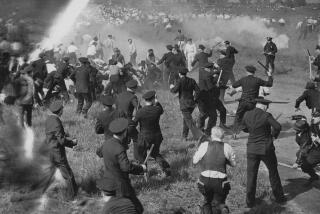Is It Really a Mutiny?
When members of a South Carolina Army Reserve unit, the 343rd Quartermaster Company, refused to drive fuel trucks on a delivery run north of Baghdad this month, there was a great clamor in the press, and some commentators unguardedly used the term “mutiny” to describe the incident.
When the term “mutiny” is invoked, one is almost immediately reminded of the tense standoff between Clark Gable’s Fletcher Christian and Charles Laughton’s Capt. Bligh in the classic film “Mutiny on the Bounty.” It is that rare a phenomenon.
Looking back through U.S. history, examples of mutiny are few, and in every instance surrounded by what an adroit defense attorney might term “mitigating circumstances.”
The first large-scale incident worthy of the term occurred in Morristown, N.J., during the winter of 1780-1781. Under the command of Gen. Anthony Wayne (commonly known as “Mad Anthony”), six regiments of the Pennsylvania Line were encamped under the most miserable of conditions. Their clothes in tatters, footwear wrapped in rags against the intense cold, they were, as one soldier recalled, “reduced to dry bread and beef for our food, and to cold water for our drink. Neither officers or soldiers have received a single drop of spirituous liquors from the public magazines since the 10th of October last ... and what was once a poor substitute for a blanket (now divided among three soldiers), is but very wretched living and shelter against the winter’s piercing cold, drifting snows and chilling sleets. Our soldiery ... have now served their country with fidelity for near five years, poorly clothed, badly fed and worse paid.” When the cold, dejected and starving Pennsylvania Line soldiers rose up in protest of reenlistment practices, they took matters into their own hands and decided to take their complaints directly to the source -- Congress. The affair ended when a commission appointed to adjudicate the men’s demands resolved the dispute peacefully.
A similar incident among New Jersey regiments shortly thereafter was quickly put down, with two of the ringleaders facing a firing squad composed of their former comrades.
Freezing, ragged, hungry and unpaid after years of hard service, the soldiers from Pennsylvania and New Jersey had reached the end of their rope. There are few who would say that they did not have reason to be unhappy with their situation, and many who would say that they were driven to mutiny by intolerable conditions. Subsequent wars involving the United States each saw incidents of revolt in the ranks. In the War of 1812, large numbers of the Tennessee Volunteers walked away from the command of Andrew Jackson and the Creek Campaign in Alabama. Jackson, rather an irascible individual at the best of times, is reported to have forestalled the departure of a large number of other Volunteers by single-handedly confronting a mass of them. The musket he carried turned out to be rusted and nonfunctional, but the Volunteers buckled to Jackson’s iron will -- and possibly his reputation as a tough customer -- and returned to duty. The Volunteers had sufficient cause to complain; they were ravaged by disease and their terms of service had expired. In this case no charges were brought.
In 1862, most of the soldiers of the Anderson Cavalry serving in the Union’s Army of the Potomac likewise disregarded orders, feeling that they had been “deceived by their recruiting officers.” Again the supposedly “mutinous” actions resulted in no prison terms for those involved.
Perhaps the most noteworthy incident of mutiny occurred in July 1944, when two ammunition ships being loaded in Port Chicago (just north of San Francisco) exploded, leveling the port facility and killing more than 300 people. Of those killed, 202 were black ammunition handlers on duty with the Navy. Unnerved by the accident, many of the surviving black stevedores refused to return to work in what they felt were unsafe conditions. Most of their complaints were ultimately found to have merit -- conditions and grievances were redressed, and eventually all but 50 returned to their duties. The 50 holdouts were tried for mutiny and sentenced to prison terms lasting from five to 15 years. Their convictions, however, were fought by Thurgood Marshall, the future Supreme Court justice, who got the men acquitted on appeal and released in 1946. In the Korean and Vietnam wars, there were incidents of insubordination, desertion and (in Vietnam) even a number of attempts against the lives of unpopular officers and sergeants. But there are no records of anyone being charged with mutiny.
In the current case involving the 343rd Quartermaster Company, some commentators were quick to use the term “mutiny.” But is it? As defined by Article 94 of the Uniform Code of Military Justice, mutiny applies to anyone who, “with intent to usurp or override lawful military authority, refuses in concert with any other person to obey orders or otherwise do his or her duty or creates any violence or disturbance.” One can now expect a long and intense scrutiny of the facts of the current incident to determine whether it meets the test. Remember, the operable term in the definition of mutiny is “lawful,” and it must be proved that the orders given the soldiers in question were in fact lawful.
Should the investigations prove that there were indeed serious mechanical and security issues of legitimate concern to the drivers -- that the fears of the soldiers were justified and their allegations were true -- then it is highly unlikely that any legal action will be forthcoming.
This is not, to the dismay of some, the stuff of high drama. On the face of it there is little likelihood that the case involving the 343rd Quartermaster Company will rise to the level of mutiny.
More to Read
Sign up for Essential California
The most important California stories and recommendations in your inbox every morning.
You may occasionally receive promotional content from the Los Angeles Times.










